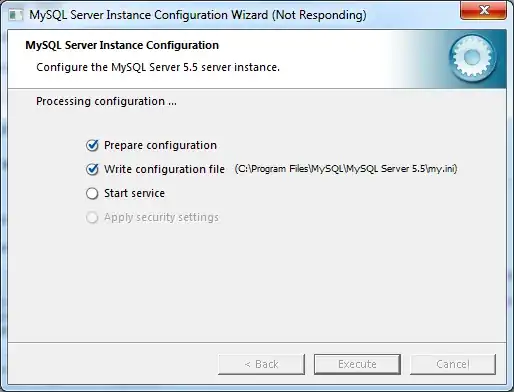I've run into a brick wall trying to install MySQL v5.5 on my machine.
My PC is Windows 7 x64, Enterprise edition.
MySQL installs fine, but when I run the "MySQL Instance Configuration Wizard", it pauses forever on the step "Start Service" (I can let it run for 30 minutes with no response). If I go into services, I see that the "MySQL" service hasn't started, and if I try to start it, it says "Windows could not start MySQL Service on Local Computer. Error 1067: The process terminated unexpectedly."
I've tried the following:
- Turning off firewall.
- Uninstalling all antivirus software.
- Installing / reinstalling 32-bit version of MySQL.
- Installing / reinstalling 64-bit version of MySQL.
- Uninstalling, deleting the contents of "C:\program files\MySQL" and "C:\program files (x86)\MySQL", reinstalling.
- Checking to see that there is no rogue services named MySQL???? (from a previous install).
- Checking that port 3306 is not used by an alternate program.
- Changing the default port that MySQL uses.
- Checking for "my.ini" and "my.ini.cnf" in "C:\windows" (nothing there but that can cause a problem).
- Running both MySQL installer, and configuration wizard, in "Adminstrator mode".
- Turning off UAC.
- Installing with defaults, not changing anything.
- Rebooting my machine (about 6 reboots so far).
- Opening up port 3306 in the firewall (both TCP and UDP, inbound and outbound).
- Swearing at the klutz of a programmer who designed MySQL so you can't even install it (as if that would help!)
My machine is working 100% in every other way. InfiniDB (a MySQL compatible database) installs 100%, as does Visual Studio 2010, Microsoft SQL Server, etc, etc.
Your advice on how to work around this?
p.s. Here is the screen it got stuck on for 15 minutes until I killed the process:

Update 2010-12-20
Tried MySQL v5.1, it didn't work either. Its amazing - if you type "mysqld /?", or "mysqld -help", it doesn't give you any help. And, if you try to restart the service manually, it doesn't display any error messages. Could it be any more unhelpful?
Update 2010-12-21
Installed MySQL 6.0 alpha, and it worked. However, I'd rather not use an alpha release, given that the "stable" release is anything but :(
Update 2010-12-21
Found http://dev.mysql.com/doc/refman/5.1/en/windows-troubleshooting.html, dealing with troubleshooting under Windows.
Discovered that you can generate an error log if the service doesn't start - see here: http://dev.mysql.com/doc/refman/5.1/en/error-log.html
Update 2010-12-21
Aha! A clue. To actually see the error, add "--console":
mysqld --console
This returns:
101221 13:57:28 [Note] Plugin 'FEDERATED' is disabled.
InnoDB: The InnoDB memory heap is disabled
InnoDB: Mutexes and rw_locks use Windows interlocked functions
InnoDB: Compressed tables use zlib 1.2.3
101221 13:57:28 InnoDB: Initializing buffer pool, size = 203.0M
101221 13:57:28 InnoDB: Completed initialization of buffer pool
InnoDB: Error: log file .\ib_logfile0 is of different size 0 56623104 bytes
InnoDB: than specified in the .cnf file 0 106954752 bytes!
101221 13:57:28 [ERROR] Plugin 'InnoDB' init function returned error.
101221 13:57:28 [ERROR] Plugin 'InnoDB' registration as a STORAGE ENGINE failed.
101221 13:57:28 [ERROR] Unknown/unsupported storage engine: INNODB
101221 13:57:28 [ERROR] Aborting
101221 13:57:28 [Note] mysqld: Shutdown complete
Update 2010-12-21
It now installs properly. See the answer below.